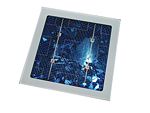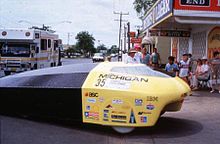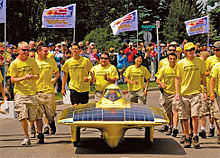- North American Solar Challenge
-


The American Solar Challenge (ASC), previously known as Sunrayce, the American Solar Challenge, and the North American Solar Challenge, is a solar car race across the United States and Canada. In the race, teams from colleges and universities throughout North America design, build, test, and race solar-powered vehicles in a long distance road rally-style event. ASC is a test of teamwork, engineering skill, and endurance that stretches across thousands of miles of public roads.
The 2010 ASC took place from June 20-26, on an 1100 mile route from Tulsa, Oklahoma to Naperville, Illinois. The 2008 NASC took place on July 13-22, 2008, on a route between Dallas, Texas and Calgary, Alberta, a total of 2500 miles.
Contents
Format and Organization
Rules
- Race consists of a series of timed stages between predetermined locations; all teams begin and end each stage in the same location
- The team with the lowest overall elapsed time wins
- The total area of all solar cells and related reflectors, etc. must not exceed 6 square meters
- When the vehicle has stopped, the solar array may be reoriented toward the sun for charging batteries
- Strict specifications and engineering scrutiny process is provided for vehicle configuration, safety requirements, and other standards
- Teams in the race are divided into two categories; open and stock
-
- Open class — Solar cells over $10 USD per watt (higher efficiency)
- Stock class — From a pre-approved list of cells that are under $10 per watt
- (Previous races also specified different battery technologies for the classes)
Race route
The 1990 and 1993 races had a south-north orientation, intended to roughly match the Darwin-to-Adelaide, Australia, route of the World Solar Challenge. In 1995, race organizers opted for a mostly east-west route from Indianapolis to Colorado. In 2005, the ASC adopted its current route that follows a south-to-north orientation across the United States, then turns to the west upon reaching Canada.
Since 1995, the Race Director has been Dan Eberle, a professor at Crowder College in Neosho, Missouri.
History
Originally called Sunrayce USA, the first race was organized and sponsored by General Motors in 1990 in an effort to promote automotive engineering and solar energy among college students. At the time, GM had just won the inaugural World Solar Challenge in Australia in 1987; rather than continue actively racing, it instead opted to sponsor collegiate events.
Subsequent races were held in 1993, 1995, 1997 and 1999 under the name Sunrayce [year] (e.g. Sunrayce 93). In 2001, the race was renamed American Solar Challenge and was sponsored by the United States Department of Energy and the National Renewable Energy Laboratory. Beginning in 2005, its name changed again to its present form to reflect the border crossing into Canada and the addition of co-sponsor Natural Resources Canada.
After the 2005 race, the U.S. Department of Energy discontinued its sponsorship, resulting in no scheduled race for 2007. The race is now sponsored by Toyota.[1]
1990
The original, 1,800 mi (2,900 km) Sunrayce USA route started at Disney World in Orlando, Florida and ended at the General Motors Technical Center in Warren, Michigan. The winner of the first race was the University of Michigan Solar Car Team's Sunrunner, with an average speed of 24.7 mph (39.8 km/h), followed by Western Washington University's Viking XX.
Overall Standings
1993
Sunrayce 93 was held June 20-26, 1993. The race route covered over 1,100 miles (1,800 km) starting in Arlington, TX and ending in Minneapolis, Minnesota. The first place car was Maize & Blue from the University of Michigan followed by the Intrepid from Cal Poly Pomona.
Overall Standings
1995
Sunrayce 95 ran along a 1,600-mile (2,600 km) route from Indianapolis, Indiana to Golden, Colorado. Massachusetts Institute of Technology won the race with an average speed of 37.23 mph (59.92 km/h), followed by the University of Minnesota just 18 minutes behind.
1997
California State University-Los Angeles's Solar Eagle III won the nine-day Sunrayce 97. Solar Eagle III averaged 43.29 mph (69.67 km/h), followed by MIT's Manta GT in second place.
Sunrayce 1997 ran from Indianapolis, Indiana to a finish line in Colorado Springs, Colorado.
1999
Sunrayce 99, running from Washington, D.C., to Orlando, Florida, was notable for its lack of sunshine. The University of Missouri-Rolla's Solar Miner II won the race with an average speed of 25.3 mph (40.7 km/h). The car from Queen's University placed second.
2001
In 2001, the race changed its name to the American Solar Challenge and followed a new route from Chicago, Illinois to Claremont, California along much of the old U.S. Route 66. The University of Michigan won the overall race and the Open Class with a total elapsed time of 56 hours, 10 minutes, and 46 seconds, followed by the University of Missouri-Rolla. The University of Arizona team won the Stock Class event.[2]
2003
The Solar Miner IV from the University of Missouri-Rolla won the 2003 race overall, as well as the Open Class; the Stock Class was won by the Prairie Fire GT from North Dakota State University.
2005
The 2005 race, renamed the North American Solar Challenge, was the longest and most hotly contested race so far. The route covered 2,494.9 mi (4,015.2 km), taking the teams from Austin, Texas in the United States to Calgary, Alberta in Canada. The race was won by the Momentum from the University of Michigan with an average speed of 46.2 mph (74.4 km/h). The University of Minnesota's Borealis III followed in second place. The lead teams often drove 65 mph (105 km/h) (the maximum allowed), but were slowed by rain in Kansas and 20 mph (32 km/h) headwinds in Canada. Stanford University's Solstice won the Stock Class in 2005, followed in second place by the Beam Machine from The University of California, Berkeley.
2008
The 2008 North American Solar Challenge took place on July 13-22, 2008, along a route from Dallas, Texas to Calgary, Alberta.[3] The University of Michigan's Continuum won the race with a total elapsed time of 51 hours, 41 minutes, and 53 seconds, marking that school's fifth victory. The Ra 7 from Principia College followed in second place.
As many of the top cars were bumping up against the 65 mph (105 km/h) race speed limit in the 2005 event, race rules were changed for 2008 order to improve safety and limit performance. Open class cars are now only allowed 6 square meters of active cell area, and upright seating is required for both open and stock class cars. The changes were carried over from the 2007 World Solar Challenge.
2010
The 2010 race, renamed the American Solar Challenge, ran June 20-26, 2010. The University of Michigan finished in first place, followed by the University of Minnesota in 2nd and team Bochum from Germany in 3rd. The race route was entirely within the United States. It started in Tulsa, Oklahoma, passing through Neosho, MO, Topeka, KS, Jefferson City, MO, Rolla, MO, Alton, IL, and Normal, IL to end in Naperville, Illinois.
See also
- Solar car racing
- World Solar Challenge
- South African Solar Challenge
- The Solar Car Challenge
- List of solar car teams
- The Quiet Achiever, the world's first solar-powered racecar
References
External links
- North American Solar Challenge
- Formula Sun Grand Prix
- CSTV Video Documentary of 2005 NASC
- Video coverage of the race from 1990, 1993, and 1997
Photovoltaics Concepts - Photoelectric effect
- Photovoltaics
- History of photovoltaics
- Timeline of solar cells
- Solar insolation
- Solar constant
- Solar cell efficiency
- Third generation photovoltaic cell
- Solar cell research
- Quantum efficiency of a solar cell
- Cadmium telluride
- Thermophotovoltaic
- Polycrystalline silicon photovoltaics
- Thermodynamic efficiency limit
- Sun-free photovoltaics
- Polarizing organic photovoltaics

Photovoltaic system Solar cells- Solar cell
- Solar panel
- Thin film solar cell
- Polymer solar cell
- Nanocrystal solar cell
- Organic solar cell
- Quantum dot solar cell
- Hybrid solar cell
- Plasmonic solar cell
- Carbon nanotubes in photovoltaics
- Dye-sensitized solar cell
- Cadmium telluride photovoltaics
- Copper indium gallium selenide solar cells
- Multijunction photovoltaic cell
- Printed solar panel
System components- Solar charge controller
- Solar inverter
- Solar micro-inverter
- Solar cable
- Solar combiner box
- Photovoltaic mounting system
- Maximum power point tracker
- Solar tracker
- Solar shingles
- Solar mirror
System concepts- Perturb and observe method
- Incremental conductance method
- Constant voltage method
- Fill factor
- Concentrated photovoltaics
- Photovoltaic thermal hybrid solar collector
- Space-based solar power
- Watt-peak
Applications Appliances- Solar-powered refrigerator
- Solar air conditioning
- Solar lamp
- Solar charger
- Solar backpack
- Solar tree
- Solar-powered pump
- Solar-powered watch
- Solar Tuki
- Photovoltaic keyboard
- Solar road stud
- Solar cell phone charger
- Solar notebook
- Solar powered calculator
- Solar powered fountain
- Solar powered radio
- Solar powered flashlight
- Solar fan
- Solar street light
- Solar traffic light
Land transport- Solar vehicle
- Solar car
- Solar roadway
- Solar golf cart
- The Quiet Achiever
- Sunmobile
Air transport- Electric aircraft
- Mauro Solar Riser
- Solar panels on spacecraft
- Solar-Powered Aircraft Developments Solar One
- Gossamer Penguin
- Qinetiq Zephyr
- Solar Challenger
Water transportSolar vehicle racing- Solar car racing
- List of solar car teams
- Solar challenge
- Solar Cup
- Blue Sky Solar Racing
- Frisian Solar Challenge
- UC Solar Team
- Solar Splash
- South African Solar Challenge
- Tour de Sol
- World Solar Challenge
- Hunt-Winston School Solar Car Challenge
- North American Solar Challenge
- Victorian Model Solar Vehicle Challenge
Generation systems - Solar Energy Generating Systems
- Stand-alone photovoltaic power system
- Grid-connected photovoltaic power system
- Rooftop photovoltaic power station
- Topaz Solar Farm
- Solar Ark
- Solar Umbrella house
- Erlasee Solar Park
- Guadarranque solar power plant
- Pocking Solar Park
- Copper Mountain Solar Facility
- Wyandot Solar Facility
- Köthen Solar Park
- Building-integrated photovoltaics
- Moura Photovoltaic Power Station
- Nevada Solar One
- Beneixama photovoltaic power plant
- Gottelborn Solar Park
- Darro Solar Park
- Olmedilla Photovoltaic Park
- Blythe Photovoltaic Power Plant
- Strasskirchen Solar Park
- Puertollano Photovoltaic Park
- Alamosa photovoltaic power plant
By countryList of countries by photovoltaics productionPV companies  Category ·
Category ·  CommonsCategories:
CommonsCategories:- Solar car races
- Photovoltaics
Wikimedia Foundation. 2010.





